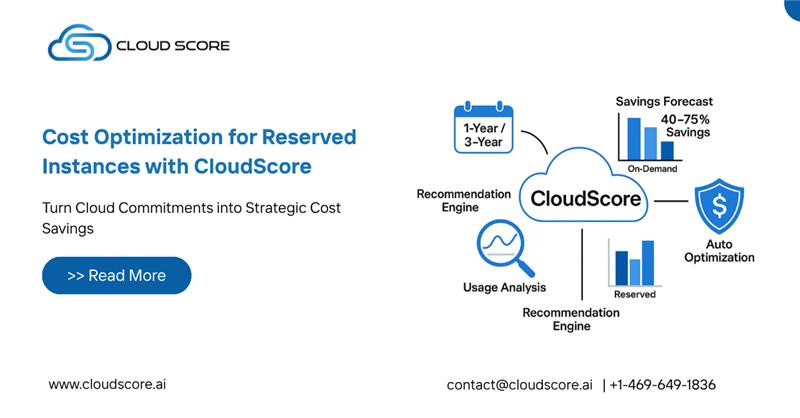
In the ever-evolving landscape of cloud computing, managing costs effectively is paramount for organizations striving to maximize their return on investment. One of the most potent strategies for achieving substantial cost savings is through the utilization of reserved instances. Reserved instances allow organizations to commit to a specific amount of compute capacity for a term of one or three years, often at a significantly discounted rate compared to on-demand pricing. CloudScore, a leading cloud cost optimization platform, provides the tools and insights necessary to leverage reserved instances effectively and achieve remarkable cost reductions.
Understanding Reserved Instances
Reserved instances are a pricing model offered by major cloud service providers such as AWS, Azure, and Google Cloud. By committing to use a specific instance type in a particular region for a set period, organizations can receive a significant discount, often ranging from 30% to 75% compared to on-demand pricing. This model is particularly beneficial for workloads with predictable usage patterns and long-term stability.
However, the challenge lies in identifying which instances to reserve and how to balance the commitment with the dynamic nature of cloud workloads. This is where CloudScore comes into play.
How CloudScore Facilitates Cost Optimization
CloudScore provides a comprehensive suite of tools designed to analyze historical usage patterns, forecast future needs, and recommend the optimal reserved instances for your organization. Here’s how CloudScore can help:
- Analyzing Past Usage Data
CloudScore starts by collecting and analyzing historical usage data across your cloud environments. This data includes metrics such as CPU and memory utilization, instance uptime, and usage patterns over time. By examining this data, CloudScore can identify instances that are consistently used and those that are underutilized.
- Identifying Suitable Instances for Reservation
Once the analysis is complete, CloudScore uses advanced algorithms to identify which instances are suitable candidates for reservation. The platform considers factors such as instance type, region, and usage consistency. This ensures that the recommended instances align with your organization’s workload requirements and can deliver maximum cost savings.
- Providing Detailed Cost-Benefit Analysis
CloudScore generates a detailed cost-benefit analysis for each recommended reserved instance. This analysis includes potential savings compared to on-demand pricing, the break-even point for the reservation, and the financial impact over the reservation term. By presenting this information in an easy-to-understand format, CloudScore empowers decision-makers to make informed choices about their cloud investments.
- Implementing Reserved Instances
With the recommendations and analysis in hand, organizations can confidently proceed with reserving the identified instances. CloudScore provides step-by-step guidance on how to reserve instances with major cloud providers, ensuring a smooth and efficient implementation process.
- Monitoring and Adjusting Reservations
CloudScore doesn’t stop at implementation. The platform continuously monitors the usage of reserved instances to ensure they are utilized effectively. If there are changes in workload patterns or new optimization opportunities, CloudScore provides timely alerts and recommendations to adjust reservations accordingly.
Real-World Example: A Case Study
Consider a mid-sized e-commerce company that relies heavily on cloud infrastructure to support its online store, customer database, and analytics platform. The company has experienced fluctuating cloud costs due to varying traffic patterns and the use of on-demand instances. By leveraging CloudScore’s cost optimization capabilities, the company embarked on a journey to reduce its cloud expenses through reserved instances.
Step 1: Data Analysis
CloudScore analyzed the company’s cloud usage data over the past year, identifying several instance types that were consistently utilized, particularly during peak shopping seasons.
Step 2: Recommendation
Based on the analysis, CloudScore recommended reserving a mix of general-purpose and compute-optimized instances in the regions where the company had the highest traffic. The platform projected potential savings of 45% compared to the current on-demand pricing.
Step 3: Implementation
With CloudScore’s guidance, the company reserved the recommended instances for a term of three years. The reservation process was straightforward, thanks to the platform’s clear instructions.
Step 4: Continuous Monitoring
CloudScore continued to monitor the usage of the reserved instances, providing monthly reports on cost savings and utilization. The company was able to adjust its reservations based on real-time data, ensuring optimal resource allocation and cost efficiency.
Outcome
Within the first year, the company achieved significant cost savings, reducing its cloud expenditure by over 40%. The financial predictability provided by reserved instances also allowed the company to allocate resources more effectively and plan for future growth.
Cost optimization through reserved instances is a powerful strategy for organizations looking to manage their cloud expenses effectively. CloudScore simplifies this process by providing the tools and insights needed to make informed decisions, implement reservations, and continuously monitor and adjust resources. By leveraging CloudScore’s capabilities, organizations can achieve substantial cost savings, enhance financial predictability, and focus on driving their core business objectives.
Ready to maximize your cloud savings with reserved instances?
Discover how CloudScore can help you optimize your cloud costs effortlessly.
Get started with CloudScore today and unlock powerful insights for smarter cloud spending!
Request a Demo | Start Your Free Trial | Contact Our Experts

